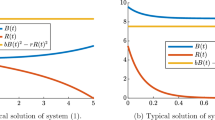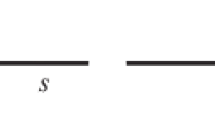Summary
This paper studies the parametric dependence of battle outcome (in particular, force annihilation) for combat between two homogeneous forces modelled by Lanchester-type equations of modern warfare with time-dependent attrition-rate coefficients. Force-annihilation prediction has been shown to depend on a so-called parity-condition parameter, which depends on only the attrition-rate coefficients. New important results are given on how the parity-condition parameter depends on the intensity of combat and the relative fire effectiveness of the combatants. Previous analytical results of the author are shown to apply to a much wider class of attrition-rate coefficients. These new results allow a wide class of Lanchester-type equations of modern warfare with temporal variations in fire effectiveness to be studied almost as easily as Lanchester's classic constant-coefficient model.
Zusammenfassung
Diese Arbeit untersucht die Parameter-Abhängigkeit von Ergebnissen kriegerischer Auseinandersetzungen zweier homogener Gegner (insbesondere Vernichtung eingesetzter Kräfte), die mit Gleichungen der Lanchester-Theorie mit zeitabhängigen Verlustraten modelliert werden. Es wurde gezeigt, daß die Vorhersage der Vernichtung von Kräften von sogenannten Paritätsbedingungen nur von Verlustraten abhängen. Neue wichtige Ergebnisse geben Auskunft, wie diese Paritätsbedingungen von der Kampfintensität und der relativen Feuereffektivität der Gegner abhängen. Bisherige analytische Ergebnisse des Autors können Anwendung in einer viel umfangreicheren Art von Verlustraten finden. Diese neuen Ergebnisse erlauben es, daß eine umfangreiche Art von Gleichungen der LanchesterTheorie moderner Kriegsführung mit zeitlicher Feuereffektivitätsveränderung beinahe so leicht untersucht werden können, wie das klassische Modell von Lanchester mit konstanter Verlustrate.
Similar content being viewed by others
References
Bieberbach L (1965) Theorie der gewöhnlichen Differentialgleichungen, 2. Auflage. Springer-Verlag, Berlin Heidelberg New York
Bonder S (1965) A theory for weapon systems analysis. In: Proceedings of the Fourth Annual US Army Operations Research Symposium, Redstone Arsenal, Alabama, pp 111–128
Bonder S (1967) The Lanchester attritionrate coefficient. Oper Res 15:221–232
Bonder S (1970) The mean Lanchester attrition rate. Oper Res 18: 179–181
Bonder S (1971) Systems analysis: A purely intellectual activity. Mil Rev 51, no. 2: 14–23
Bonder S, Farrell RL (eds) (1970) Development of models for defense systems planning. Report No. SRL 2147 TR 70-2 (U), Systems Research Laboratory, The University of Michigan, Ann Arbor, Michigan
Bostwick SP, Brandi FX, Burnham CA, Hurt JJ (1974) The interface between DYNTACS-X and Bonder-IUA. In: Proceedings of the Thirteenth Annual U.S. Army Operations Research Symposium, Fort Lee, Virginia, pp 494-502
Clark GM (1969) The combat analysis model. Ph. D. Thesis. The Ohio State University, Columbus, Ohio
Dolansky L (1964) Present state of the Lanchester theory of combat. Oper Res 12: 344–358
Farrell RL (1975) VECTOR 1 and BATTLE: Two versions of a high-resolution ground and air theater campaign model. In: Huber RK, Jones LF, Reine E (eds) Military strategy and tactics. Plenum Press, New York, pp 233–241
Huber RK, Jones LF, Reine E (eds) (1975) Military strategy and tactics. Plenum Press, New York
Kamke E (1944) Differentialgleichungen, Lösungsmethoden und Lösungen, Band 1, Gewöhnliche Differentialgleichungen, 3. Aufl Akademische Verlagsgesellschaft, Leipzig (reprinted: 1971 Chelsea, New York)
Lanchester FW (1914) Aircraft in warfare: The dawn of the fourth arm-No. V, the principle of concentration. Engineering 98:422–423 (reprinted: 1956) in: Newman J (ed) The world of mathematics, Vol. IV.: Simon and Schuster, New York, pp 2138–2148
Schwarz HA (1872) Über diejenigen Fälle, in welchen die Gaussische hypergeometrische Reihe eine algebraische Function ihres vierten Elementes darstellt. J. Reine Angew. Math. 75:292–335 (= Ges. Abh. Bd. 2, S. 211–259)
Taylor JG (1974) Solving Lanchester-type equations for “modern warfare“ with variable coefficients. Oper Res 22:756–770
Taylor JG (1979) Recent developments in the Lanchester theory of combat. In: Haley KB (ed) Operational Research '78. Proceedings of the Eighth IFORS International Conference on Operational Research. North-Holland, Amsterdam, pp 773–806
Taylor JG (1979) Attrition modelling. In: Huber RK, Niemeyer K, Hofmann HW (eds) Operations-analytische Spiele für die Verteidigung. R. Oldenbourg, München, pp 139–189
Taylor JG (1979) Prediction of zero points of solutions to Lanchester-type differential combat equations for modern warfare. SIAM J Appl Math 36:438–456
Taylor JG (1980) Force-on-force attrition modelling. Military Applications Section of Operations Research Society of America, Arlington, Virginia
Taylor JG, Brown GG (1976) Canonical methods in the solution of variable-coefficient Lanchester-type equations of modern warfare. Oper Res 24:44–69
Taylor JG, Comstock C (1977) Force-annihilation conditions for variable-coefficient Lanchester-type equations of modern warfare. Nav Res Log Qu 24: 349–371
Taylor JG, Parry SH (1975) Force-ratio considerations for some Lanchester-type models of warfare. Oper Res 23:522 to 533
Wallis PR (1968) Recent developments in Lanchester theory. Oper Res Qu 19: 191–195
Weiss HK (1957) Lanchester-type models of warfare. In: Davies M, Eddison RJ, Page T (eds) Proceedings of the First International Conference on Operational Research. Operations Research Society of America, Baltimore, pp 82–98
Weiss HK (1959) Some differential games of tactical interest and the value of a supporting weapon system. Oper Res 7:180–196
Author information
Authors and Affiliations
Additional information
This research was partially supported by the U.S. Army Research Office, Durham, North Carolina, USA, under R & D Project No. 1L161102BH57-05 Math (funded with MIPR No. ARO 22-77) and partially by the Office of Naval Research.
Rights and permissions
About this article
Cite this article
Taylor, J.G. Dependence of the parity-condition parameter on the combat-intensity parameter for Lanchester-type equations of modern warfare. OR Spektrum 1, 199–205 (1980). https://doi.org/10.1007/BF01719341
Received:
Accepted:
Issue Date:
DOI: https://doi.org/10.1007/BF01719341




